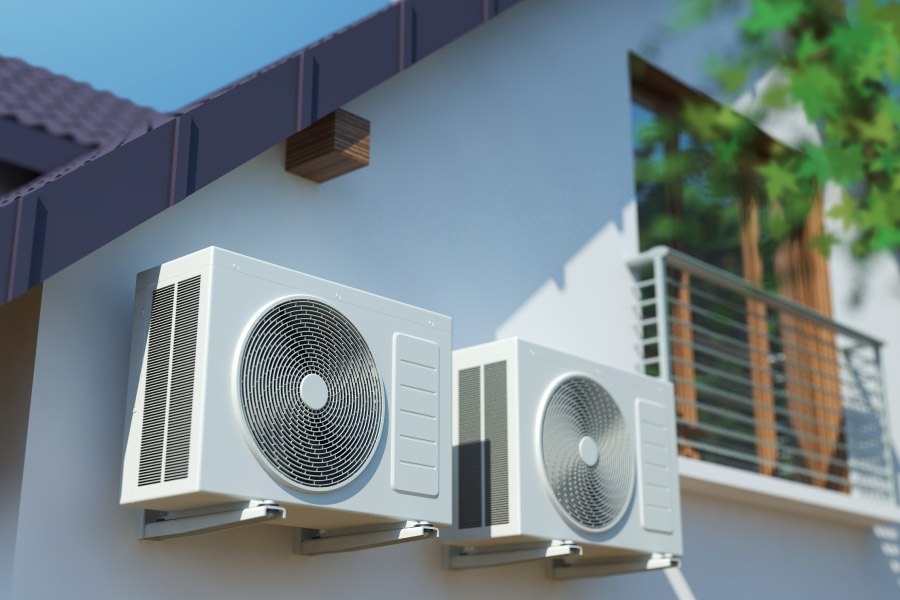As Montana starts to transition into spring, now is the perfect time to prepare for the upcoming heat. Once the summer hits, the last thing you want is for your A/C unit to be broken, in maintenance, or waiting to be replaced. Investigating your cooling options and installing a new A/C unit now can save you discomfort when we’re in the thick of summer. There are many air conditioner types on the market, so assessing their features and your cooling needs can help you pick the best unit for your home. We’ve laid out the different air conditioner types available and our top tips for selecting the right A/C unit for your needs.
Air Conditioner Types
Air conditioner types can be broken down into two larger categories: stand-alone units and split-system units. Here’s how they work:
- Stand-alone, or free-standing air conditioner units, are comprised of one device. This device contains both sets of metal coils used for cooling your home. One coil collects the heat from your home while the other dispels the heat outside.
- Split-system air conditioners use two devices to cool your home. One device (usually smaller and quieter) is located in the home, and the other device (usually bigger and noisier) is located outside. The cooling metal coil that collects heat is located in the inside unit, and the coil that dispels heat is in the outside unit.
Stand-Alone Air Conditioner Types
Portable Air Conditioner
These models are very popular for those looking for a single room air conditioner. They’re cheap, no-fuss units that can be easily moved around the room of your choice. Hot air collected by the unit is dispelled outside by an air pipe through an exterior wall or window. While they’re easy to move around, the air pipe needs to be moved as well, so they can take up extra floor space.
Window Unit Air Conditioner
These units are self-contained units that are either placed in a window or through a hole in the wall. One part of the unit faces indoors while the other faces outdoors. The part facing indoors collects the hot air, and the part facing outdoors expels the hot air outside. They come in a variety of sizes, and the bigger the unit, the more cool air it generates. You can normally install these units yourself and they typically have a low upfront cost. However, because of their singular, static locations, their cooling capabilities are limited to a single room.
Wall or Floor Mounted Air Conditioner
These air conditioner types can be both stand-alone or split-system units. Using strong supports, these units can either be mounted to the wall or floor with pipes going through the wall to release the hot air outdoors. If run continuously, the units and pipes can become warm to the touch if you are not careful. These units are typically better for single rooms, as the airflow is localized to one place. Floor mounted air conditioners typically cool the room quicker than wall mounted units, as the fan blows cool air at your level.
Split-System Air Conditioner Types
Ductless Air Conditioner
Ductless air conditioners, also known as mini split air conditioners, have become extremely popular over the years. They are great options for apartments or homes with no ductwork and those looking for a more permanent air conditioning solution than window air conditioners. They have two units that are installed on the interior and exterior of your residence. Tubing connects the two systems through the wall that separates them. These are efficient air conditioner types that can be installed in a single room or installed in each room for whole-home cooling. It can become pricy to install a mini split air conditioner in every room in the house, so central air conditioners are more optimal for whole-home cooling.
Central Air Conditioner
If you have a large home and want to cool many rooms at once, a central air conditioner is the best choice for your home. Central air conditioner units are able to cool multiple rooms in your home simultaneously and quietly. They use a split system setup, where the condensing unit is located outside and the evaporative unit is inside next to your furnace. They connect together using refrigerant tubing. The condensing unit generates cool air that is pushed into the evaporative unit. Then, the evaporative unit propels the cool air into your home through your furnace duct system. While central air conditioners are the most expensive option, they are extremely effective and efficient.
5 Tips for Choosing the Right Air Conditioner Type
- Energy Efficiency – Choosing an energy-efficient air conditioner can help you save money on your monthly energy bill in the long run. Many air conditioner types are ENERGY STAR certified, which means they meet the Environmental Protection Agency’s (EPA) standards for using less energy. The higher the ENERGY STAR number, the more energy-efficient an air conditioner is.
SEER rating is also a great measure of an air conditioner’s energy efficiency. Seasonal Energy Efficiency Ratio (SEER) rating is the air conditioner’s cooling output divided by the total energy used in a cooling session. Like ENERGY STAR ratings, the higher the SEER rating, the better the energy efficiency. - Price – Your budget is king when deciding on an air conditioner unit. If you’re looking for cheap, easy cooling for a single room, a window air conditioner or portable air conditioner maybe your best option. If you are looking for whole-home cooling, a central A/C unit is more expensive but more effective for all-around cooling. Remember that systems with a higher price tend to be more energy-efficient, which can make them less expensive to run in the long term.
- Size – You will need to make sure your A/C unit is the right size for your desired location. If you choose an air conditioner that is too large or small, it can be less efficient and use too much energy. Consult with a professional HVAC technician to ensure you choose an A/C unit with the right dimensions.
- Cooling Power – British Thermal Units (BTUs) are the measure of an air conditioner’s cooling capacity. The higher the BTU number means the more cooling power an air conditioner has. You will need an air conditioner with the BTUs necessary to properly cool your space. Air conditioners can range from 5,000 to 36,000 BTUs, so speak with an HVAC technician to evaluate how many BTUs you need to cool your space.
- Quality – You want to get the most out of your air conditioner, so choosing one that stands the test of time is important. Make sure your chosen air conditioner has reliable, well-made components so it can last you a long time. At Mountain Heating and Cooling, we recommend air conditioner brands like Trane, Lennox, and Mitsubishi for quality A/C units. Typically, more expensive units are higher in quality, but it’s important to choose an A/C unit with specifications that match your cooling needs.
If you need a hand selecting a quality A/C unit, our highly-trained HVAC technicians understand the differences between various A/C units and can help you choose the best unit for your home. Chat with our technicians today.
Need an Expert’s Advice? We’ve Got Your Back!
Choosing an air conditioner unit can be a challenge, so it’s important to get an expert’s advice to ensure your home stays comfortable and operational during the summer. If you need a hand selecting an air conditioner unit before the warm months hit, schedule an appointment with our air conditioning specialists today. At Mountain Heating and Cooling, we take the time to understand your needs and budget so that you can make informed, confident decisions for your home. To schedule an appointment, fill out a contact form or call us at (406) 586-4007.

